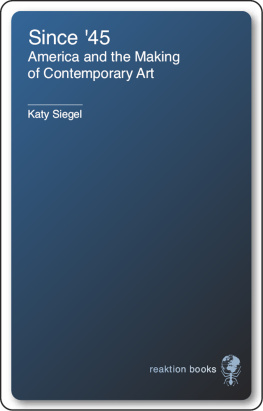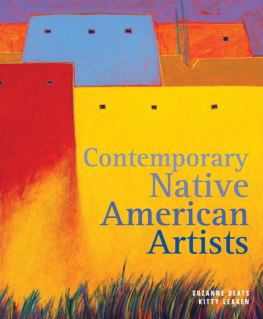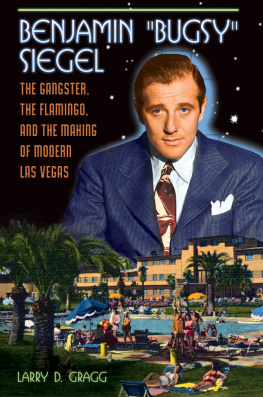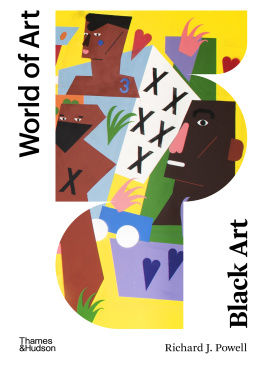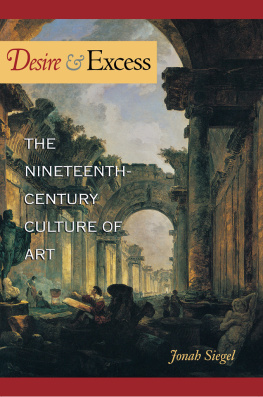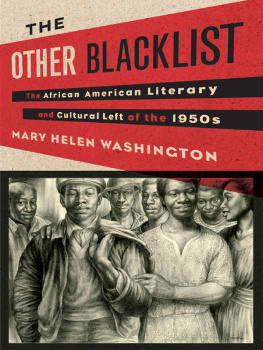No part of this publication may be reproduced, stored in a retrieval system, or transmitted, in any form or by any means, electronic, mechanical, photocopying, recording or otherwise, without the prior permission of the publishers.
by the MPG Books Group.
Siegel, Katy.
Since 45 : America and the making of contemporary art.
1. Art, America 20th century. 2. Art and society
United States History 20th century. 3. United States
Preface
My estimate of America... sometimes runs very low, sometimes to ideal prophetic proportions.
Ralph Waldo Emerson, 1862
Seek the extremes. Thats where all the action is.
Lee Lozano, 1969
This book is the outcome of a long effort to understand how contemporary art relates to history and how history, including the history of art, is written. Specifically, it is about how art has changed since 1945. For a long time I tried to think about 1945 both the year itself and all it stands forfrom a contemporary perspective, in an effort to grasp what it felt like to live at that moment, and how the experiences of that moment affected the making of art. This led me to consider what 1945 meant historically, how it shaped social conditions and art in subsequent decades, how it is still affecting the world we live in today. Finally, I have struggled with the more abstract question of how the idea of 1945 as a world-shifting event has shaped the way we understand history.
I wrote my doctoral dissertation, years ago, on the ways artists and critics in the postwar period understood time, in its historical, generational or social, and individual dimensions, utilizing such theoretical constructs as the paradigm shift and the epistemological rupture, the generation gap, and the artistic breakthrough, along with the concept of postwar itself. The dissertation traced the creation and expression of these constructs by following the use of particular terms (like new and young) in the art criticism of the time. It was a historical study, in the sense of addressing a past moment, and also in that my main subject was the way history was written, the way that art criticism became history.
In my first teaching job, I found myself working primarily with studio art undergraduate and graduate students who wanted to know about contemporary art. My own academic training andknowledge stopped with the art made in 1968, so I began teaching myself, piecemeal, about more recent art. Like most other academics, I began with artists who were not only well known but congenial to a largely theoretical or text-based understanding of their work, professorial favorites who fit neatly into the march of academic art history. But as my knowledge of art broadened and deepened, I branched out to study and teach different types of artists, including both those left out of the history because they did not fit in artistically, ideologically, or socially, and those often scorned, apparently, for their success in the art market. Learning more, I came to see that the way I had learned to understand contemporary art, largely shaped by the concepts I had examined in my thesis, was wrong.
In discussing American and contemporary European art (and, still, today, art from around the world), critics and historians relied too much on an older European model of artistic activity framed in terms of an avant-garde, rejecting the market and attempting to shock the public, with an insider intelligentsia leading clueless collectors to the important work of the moment. This model just did not fit, except, superficially, for a small group of artists, often themselves academics, who, shaping their practice after this image, hoped to place themselves in the avant-garde lineage. Art writers tended to take for granted an autonomous history of a way of making art called modernism. Of course, American postwar art had some things in common with older European modernism: the general condition of capitalism, and arts place in this social system; the wish of some artists to connect to modernist tradition; and a seeming perpetual run of beginnings and endings, particularly endings. (While these were often cast as generationalthe end of Abstract Expressionism and the takeover of Pop, for example they could also be medium-basedthe end of painting was a particularly common event.) But what was never discussed were the American social conditions, history, or earlier art that might have shaped the new art, aside from work that overtly critiqued (or was seen to critique) America. The sole exception to this was the treatment of Abstract Expressionism, portrayed by recent writers as representing America in its predilection for masculinistbombast. This was ironic, as so many of those artists not only were immigrants but felt quite alienated from many mainstream American social values.
History is the experience of the debris of the past, while criticism is the experience of art as a living thing, made by living artists, whether those artists are undergraduates in Memphis or famous artists in New York. One is attached to an interest in large-scale social transformations and abstract ideas, and the other is based on an engagement with specific art objects. Both, it turns out, have a role to play in understanding the contemporary art that began in 1945. I experienced the tension between past and present directly when learning about present-day art in order to teach my students led me to become a practicing art critic in New York, writing first for the magazine Artforum and then for museum exhibition catalogs. But although my critical writing tends to be somewhat historically inflectedand vice versabringing together two modes of practice, history, and criticism, or two fields of study, the postwar and the contemporary, required effort. To locate the continuities as well as the changes between the art world of the 1940s and that of 2010 requires looking at once backwards and forwards.
Of the many relationships between present and past, a particularly important one is the way in which the meaning of a thing (an idea, an artwork, an essay, a person) changes over time as it exists in the world. Whether the subject is the dropping of the atomic bomb or the paintings of Jackson Pollock, understanding it validly exploits hindsight and the unfolding of unforeseen consequences to follow its changing social meaning for subsequent generations. Specifically, the ways that the art of the present moment is historicized by institutions and academics helps shape its meaning. In the latter half of the twentieth century, for example, the preference for breaks and paradigm shifts as the way to write history has had an enormous influence on our perception of artistic production, if not on that production itself. But this preference can mislead, masking the continuities that exist between past and present. Even if you dont believe that the present is in general the necessary outcome of past events, it is true in particular that theart of the present, or at least our understanding of it, is very much the product of the postwar moment and the struggles to understand that time.

